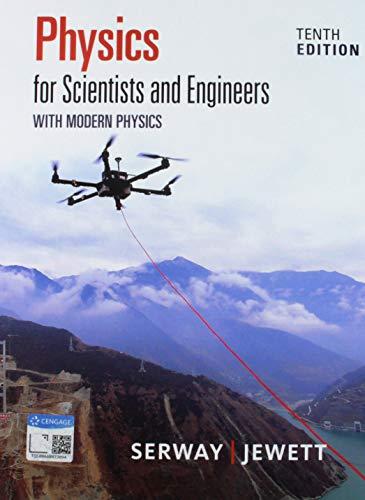
Concept explainers
In a laboratory frame of reference, an observer notes that Newton’s second law is valid. Assume forces and masses are measured to be the same in any reference frame for speeds small compared with the
(a)
To show: The Newton’s second law is valid for an observer moving at a constant speed of light, relative to the laboratory frame.
Answer to Problem 1P
The Newton’s second law is valid for an observer moving at a constant speed of light, relative to the laboratory frame.
Explanation of Solution
Assume
The Galilean coordinate transformation is,
To find the velocity, take a time derivative
Substitute
To find the acceleration, take another time derivative
Substitute
It is shown from the above equation that the accelerations are identical.
The Newton’s second law is the same.
Thus, the Newton’s second law is valid for an observer moving at a constant speed of light, relative to the laboratory frame.
Conclusion:
Therefore, the Newton’s second law is valid for an observer moving at a constant speed of light, relative to the laboratory frame.
(b)
The Newton’s second law is not valid in a reference frame moving past the laboratory frame with a constant acceleration.
Answer to Problem 1P
The Newton’s second law is not valid in a reference frame moving past the laboratory frame with a constant acceleration.
Explanation of Solution
Assume
The Galilean coordinate transformation is,
To find the velocity, take a time derivative
Substitute
To find the acceleration, take another time derivative
Substitute
It is shown from the above equation that the accelerations are not identical.
The Newton’s second does not have same value in two different frames,
Substitute
Conclusion:
Therefore, Newton’s second law is not valid in a reference frame moving past the laboratory frame with a constant acceleration.
Want to see more full solutions like this?
Chapter 38 Solutions
Bundle: Physics For Scientists And Engineers With Modern Physics, 10th + Webassign Printed Access Card For Serway/jewett's Physics For Scientists And Engineers, 10th, Multi-term
- What is the resistance (in (2) of a 27.5 m long piece of 17 gauge copper wire having a 1.150 mm diameter? 0.445 ΧΩarrow_forwardFind the ratio of the diameter of silver to iron wire, if they have the same resistance per unit length (as they might in household wiring). d. Ag dFe = 2.47 ×arrow_forwardFind the ratio of the diameter of silver to iron wire, if they have the same resistance per unit length (as they might in household wiring). d Ag = 2.51 dFe ×arrow_forward
- Show that the units 1 v2/Q = 1 W, as implied by the equation P = V²/R. Starting with the equation P = V²/R, we can get an expression for a watt in terms of voltage and resistance. The units for voltage, V, are equivalent to [? v2 v2 A, are equivalent to J/C ✓ X . Therefore, 1 = 1 = 1 A V1 J/s Ω V-A X = 1 W. . The units for resistance, Q, are equivalent to ? The units for current,arrow_forwardPlease solve and answer the question correctly please. Thank you!!arrow_forwardPlease solve and answer the question correctly please. Thank you!!arrow_forward
 Modern PhysicsPhysicsISBN:9781111794378Author:Raymond A. Serway, Clement J. Moses, Curt A. MoyerPublisher:Cengage Learning
Modern PhysicsPhysicsISBN:9781111794378Author:Raymond A. Serway, Clement J. Moses, Curt A. MoyerPublisher:Cengage Learning Principles of Physics: A Calculus-Based TextPhysicsISBN:9781133104261Author:Raymond A. Serway, John W. JewettPublisher:Cengage Learning
Principles of Physics: A Calculus-Based TextPhysicsISBN:9781133104261Author:Raymond A. Serway, John W. JewettPublisher:Cengage Learning Physics for Scientists and Engineers: Foundations...PhysicsISBN:9781133939146Author:Katz, Debora M.Publisher:Cengage Learning
Physics for Scientists and Engineers: Foundations...PhysicsISBN:9781133939146Author:Katz, Debora M.Publisher:Cengage Learning Classical Dynamics of Particles and SystemsPhysicsISBN:9780534408961Author:Stephen T. Thornton, Jerry B. MarionPublisher:Cengage Learning
Classical Dynamics of Particles and SystemsPhysicsISBN:9780534408961Author:Stephen T. Thornton, Jerry B. MarionPublisher:Cengage Learning University Physics Volume 3PhysicsISBN:9781938168185Author:William Moebs, Jeff SannyPublisher:OpenStax
University Physics Volume 3PhysicsISBN:9781938168185Author:William Moebs, Jeff SannyPublisher:OpenStax Physics for Scientists and Engineers, Technology ...PhysicsISBN:9781305116399Author:Raymond A. Serway, John W. JewettPublisher:Cengage Learning
Physics for Scientists and Engineers, Technology ...PhysicsISBN:9781305116399Author:Raymond A. Serway, John W. JewettPublisher:Cengage Learning





